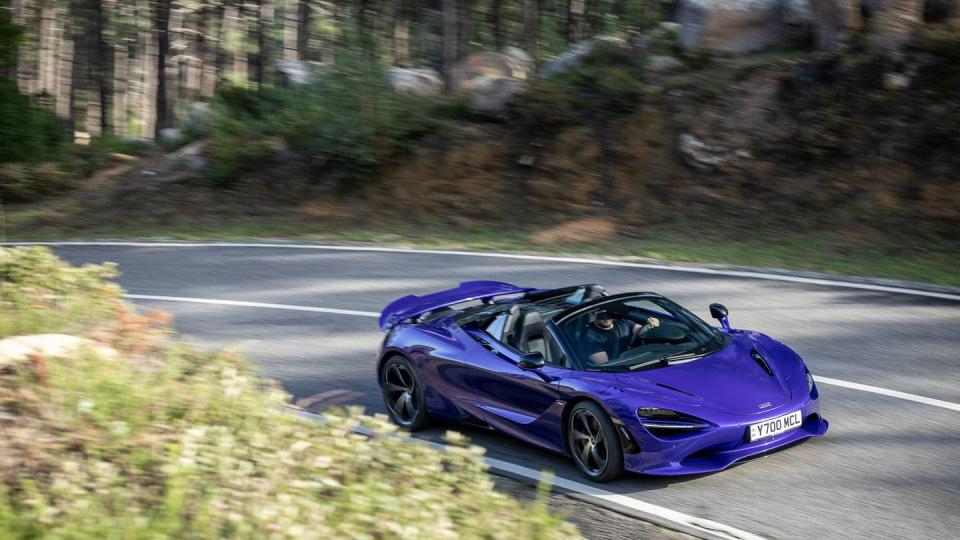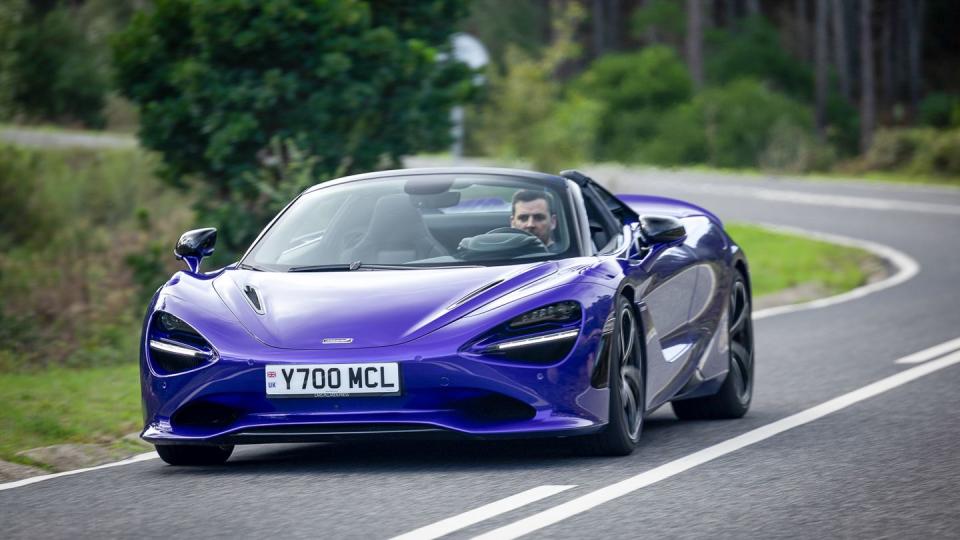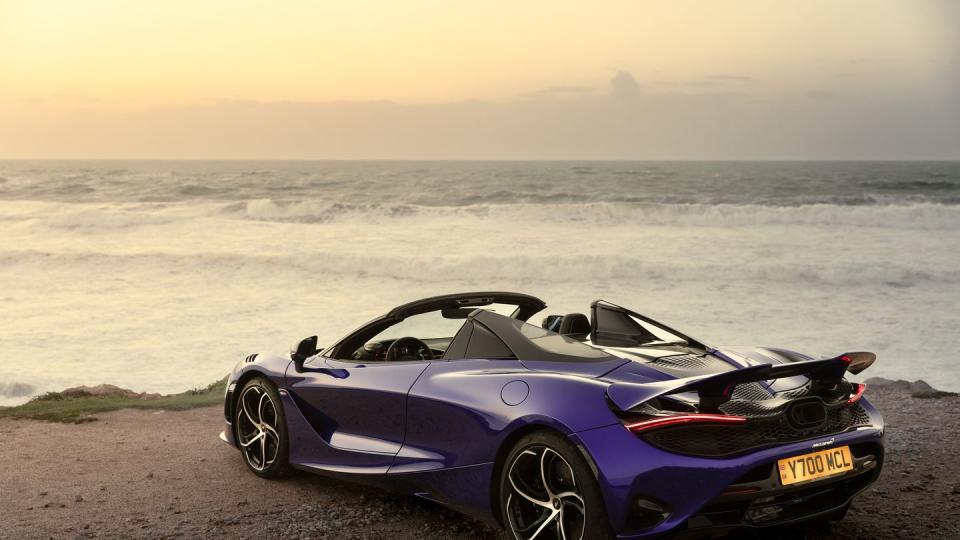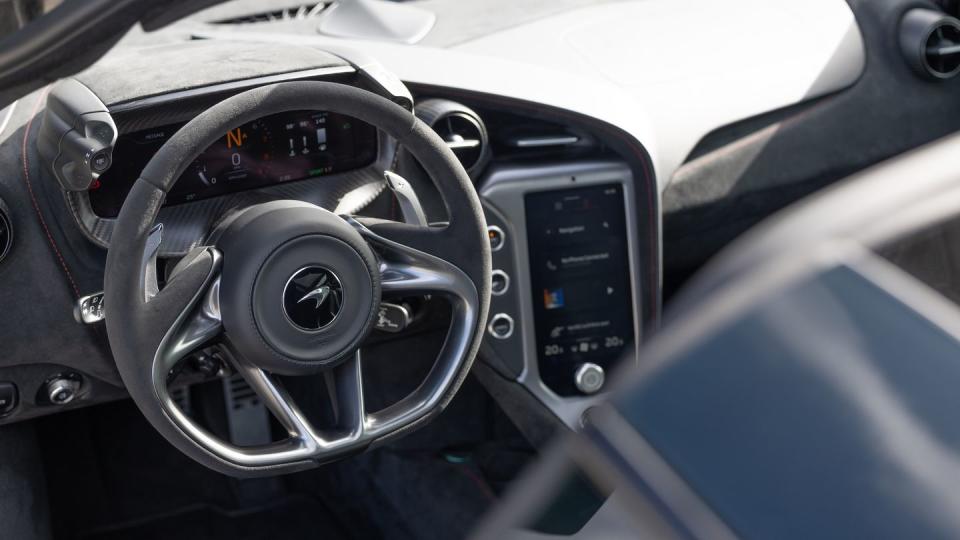The Berserk Power of the McLaren 750S

How intense is the experience of driving new McLaren 750S on Portugal’s Estoril racetrack? Well, one long-time journalist and test driver had to sit out his third and final track stint because he was convinced he’d detached a retina.
After his second stint on the 2.6-mile former F1 circuit, his vision crowded with floaters and a crescent of light appeared on the periphery of his sight. He remained remarkably calm. Others so afflicted might have demanded a medical flight to America for a quick restoration of their sight. I’m not saying I would have been one of them. But I’m not saying I wouldn’t be, either. At the very least I would have been considerably less chipper than before my eyeball started coming apart.
He did not, in fact, detach his retina. He had a normal, if inconveniently timed, vision complication. So, McLaren and its absurdly powerful and grippy supercar bears no responsibility. Nor does Estoril, its management, or the fine people of Portugal.

That all those gathered believed it was feasible that this car, an update of the six-year-old McLaren 720S, was capable of sufficient performance to discombobulate a human eye, says everything you need to know about the 750S.
It’s tempting to say that the 750S is simply too fast for public roads. This is a concept I don’t typically subscribe to, largely because I can always use less throttle to control a vehicle’s speed. Still, the sense of unfulfilled potential of driving a 750S on the same roads traversed by Nissan Rogues, is palpable. This was particularly true on my road drive though the hilly parkland north of Estoril. The tight and twisty roads were greasy from a persistent drizzle. Passing opportunities were few and far between, so getting through inevitable clogs of Seats and Transits, required decisiveness and – whoa! – much less power than I invariably requested. The 750S’s tail wagged as it tried to transfer something close to the engine’s full power (740 hp and 590 lb-ft of torque) through the rear Pirelli PZeros. They’d lose their grip on the wet road through most of two gears before I realized I was well clear of the traffic cloggers and backed out of the throttle.
McLaren says the 750S makes 30 more hp and 22 more lb-ft of peak torque than the 720S. Okay, but two things: 1. McLaren has almost certainly been underrating the output of the twin-turbo 4.0-liter V-8 since it hit the market many years ago. 2. Adding 30 more hp to an already overwhelming supply of the stuff is like adding a few more kernels to the extra-large bucket of popcorn. I mean, who’s counting?

Of greater consequence for the feel of the 750S, available as either a coupe or a spider, is that it carries shorter gearing than the 720S. In fact, it carries the same drive ratio as the limited-edition 765LT. This limits top speed to 206 mph, an inconsequential 6 mph off the 720’s terminal velocity. The gearing and additional thrust cuts the 750S’s 0-60 mph sprint to a claimed 2.7 seconds, only 0.1 second quicker than McLaren’s claim for the 720S. Does it feel quicker? Beats me. And I spent a couple of days driving a 720S up to top speed just two months before I drove the 750S. This is not to imply that the 750S isn’t quicker, as claimed. It’s just that when lifting something that weighs 50 pounds, it’s not so easy to detect when an additional several ounces is added to the load. Believe me, the 750S feels plenty berserk.
Gearing isn’t the only thing the 750S picks up from the 765LT. The new car also uses the quicker steering ratio of the now discontinued LT model. This is a more obvious change. It gives the car a more alert and lively demeanor. We’re guessing this will make the 750S a little spicier at top speed than the 720S. But who ever does that? The 750S also adds a larger active rear wing that is precisely the shape and size of the 765LT. Visually, the new car neatly splits the difference between the 720S and 765LT. Its tailpipes are pushed together at the center of the rear end, like the LT. The 750S has also had a subtle nose job, with a simpler-looking lower fascia. But the new car will frequently be mistaken for a 720S. No shame there; the 720S remains a beautiful and fresh design. The new car’s profile has the same smooth sweep, looking like a particularly expensive loafer.
The 750S’s biggest improvement is probably the thing least likely to be noticed by onlookers: the interior. In a boon for long waisted (or simply tall) drivers, the gauges are now visible. This is thanks to an instrument binnacle that’s mounted to the steering column, keeping the relationship between wheel and gauges the same regardless of the wheel adjustment. It’s not a new trick. McLaren’s been using it since the introduction of the limited-edition Elva roadster a few years back. And of course, Porsche used the same idea in the 928 as did Nissan with the later Z cars. McLaren now mounts rocker switches for the powertrain and chassis modes to the upper left and right of the binnacle hood. It’s more user-friendly solution than the center-stack-mounted dials of the 720S. And hey, look at that, Apple CarPlay is now standard.

Easily the strangest element of the new interior is an optional peephole to look at the engine. Disappointingly, McLaren has always hidden its engine deep under the body work, entirely out of view. Now, the company will be happy to sell you a 750S with a roughly 10-inch round transparent panel centered behind the seats to get a glimpse of the 4.0-liter. There is no easy way to view the peephole from inside or outside of the vehicle. It requires perhaps more craning and twisting and squinting that is justified, particularly for its $6050 price.
Fundamentally, though the 750S is a really worthwhile update to the 720S, already one of the most impressive and compliant supercars to ever exist. Forget the extra power, that was the last thing any McLaren needs. The company has taken the opportunity to fix and improve nearly every aspect of the basic car, including the already multitalented suspension system which provides meaningful differentiation between modes and makes the 750S perhaps the most day-to-day livable supercar of all time. At a base price of around $330,000 for the coupe and $350,000 for a Spider, the 750S is roughly equivalent to the Ferrari 296 GTB/GTS. That’s heady competition. But if you order your 750S now, you might take delivery of it next fall, about half as long as you might wait for a 296.
Out on the dry track, though, with gummy Pirelli PZero Trofeo R tires up to temperature and the new $18,050 McLaren Senna-inspired track brake upgrade … well, you won’t be worrying about silly options and the 750S’s supple ride over tortured public roads. You will instead be laser focused on the car’s beautiful balance, tireless stopping force, and blaring exhaust. Perhaps you’ll spare a thought for whatever physical destruction the car is exacting upon your body.

A car-lover’s community for ultimate access & unrivaled experiences.JOIN NOW Hearst Owned
You Might Also Like

 Yahoo Autos
Yahoo Autos 